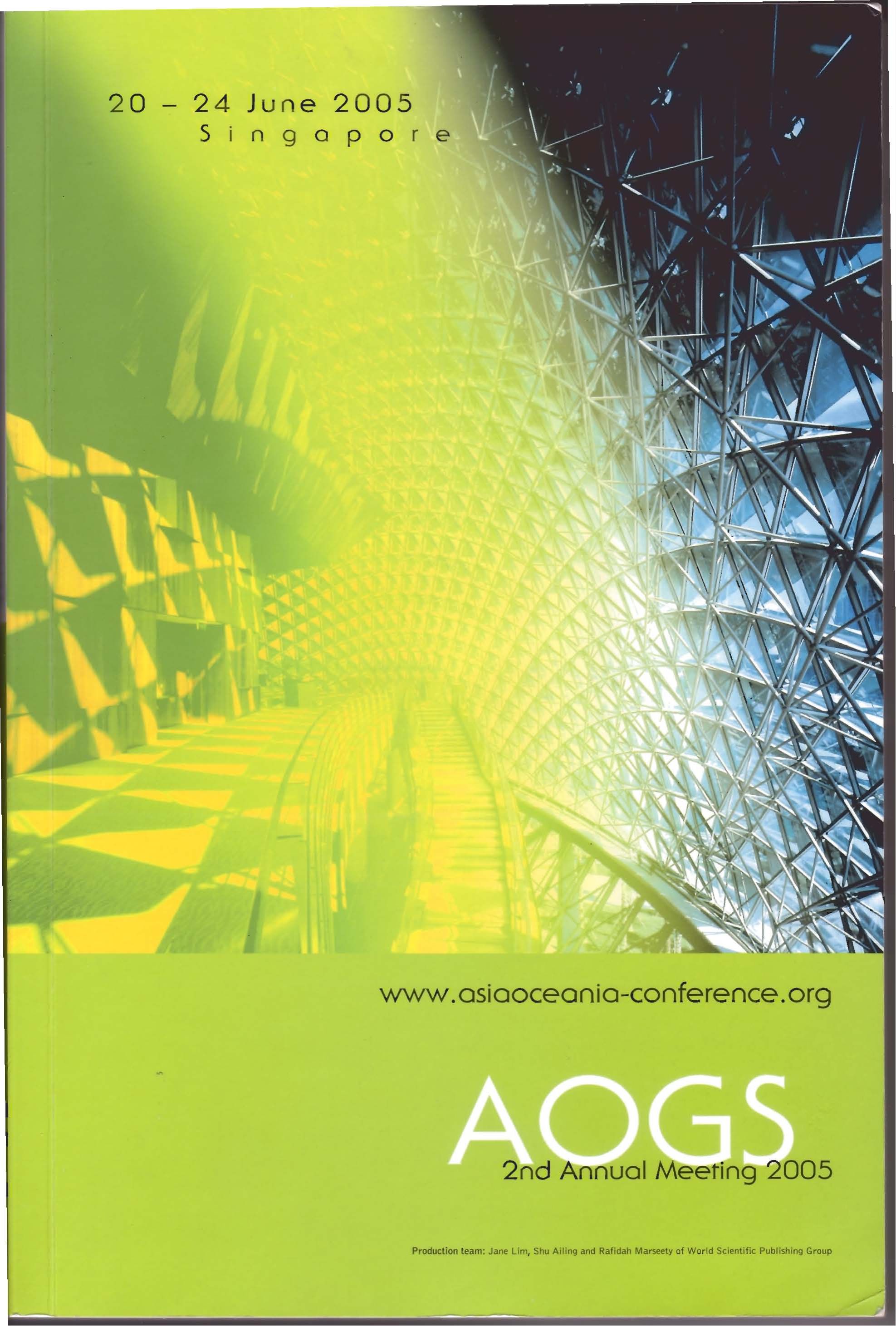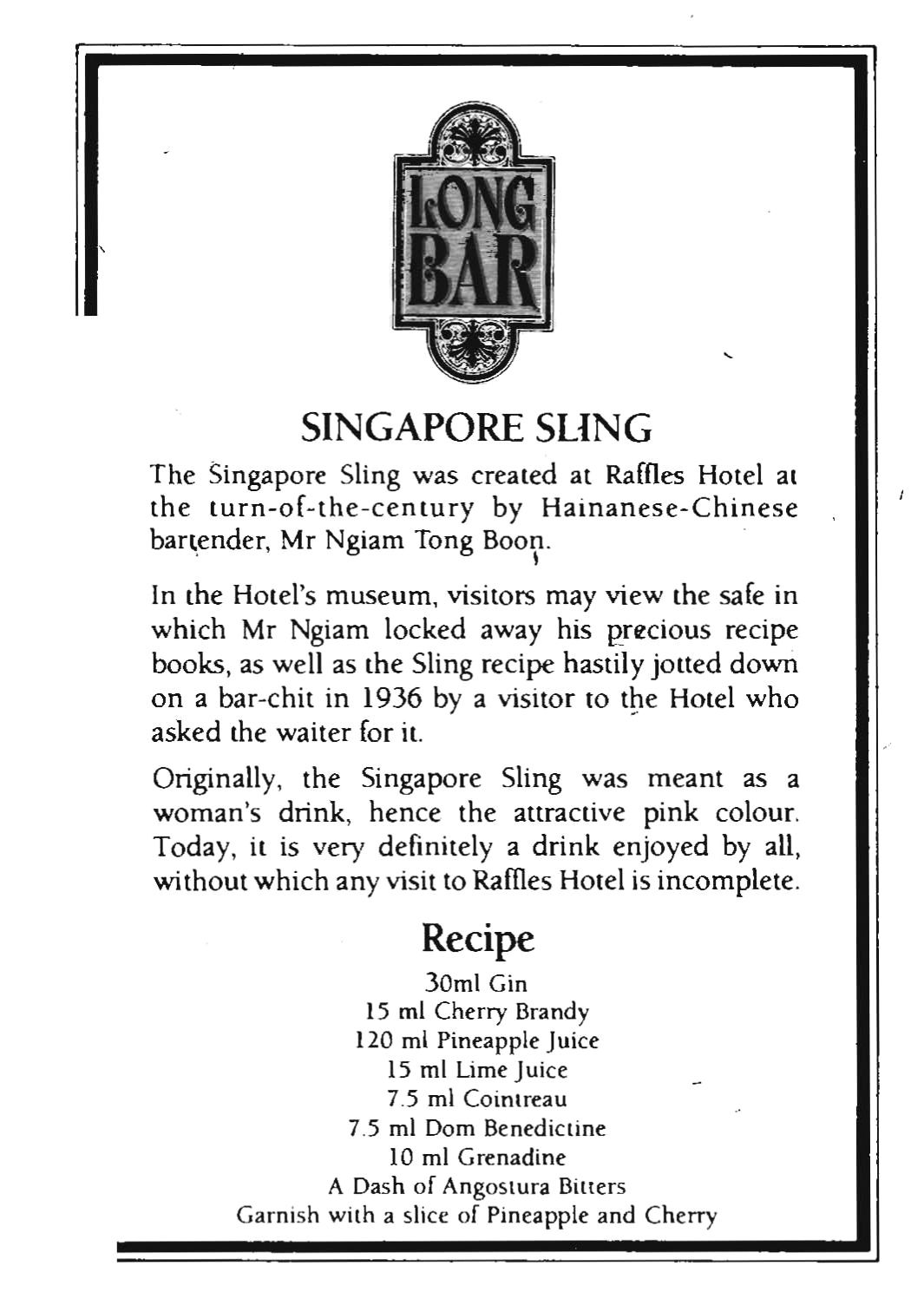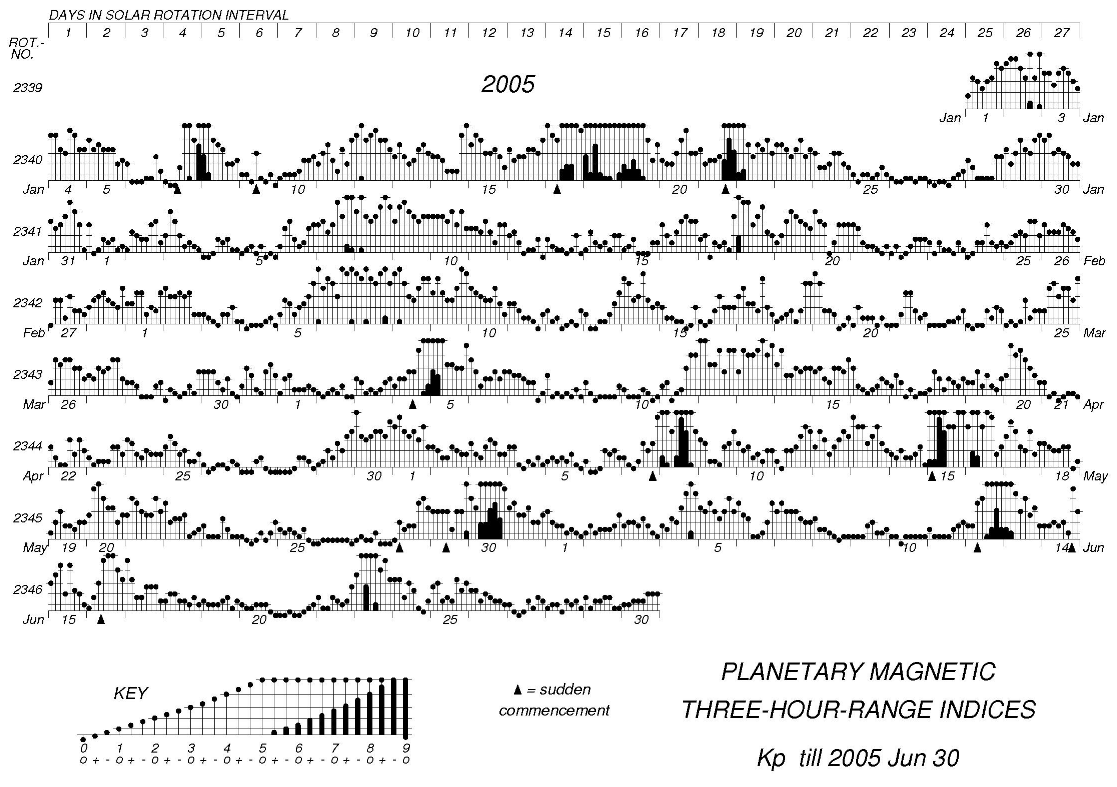News and Announcements [in Japanese]
地磁気センターニュース

★ 一覧 ★

地磁気世界資料解析センター News No.92 2005年7月28日
1.新着地磁気データ
前回ニュース(2005年5月31日発行, No.91)以降入手、または、当センターで入力したデータのうち、
主なものは以下のとおりです。オンライン利用データの詳細は
(http://swdcwww.kugi.kyoto-u.ac.jp/catmap/index-j.html) を、観測所名の省略記号等については、観測所カタログ
(http://swdcwww.kugi.kyoto-u.ac.jp/catmap/obs-j.html) をご参照ください。
また、先週の新着オンライン利用可データは、
(http://swdcwww.kugi.kyoto-u.ac.jp/wdc/onnew/onnew-j.html)で御覧になれ、2ヶ月前までさかのぼることもできます。
Newly Arrived Data
(1)Annual Reports and etc.
NGK (Apr. - Jan., 20055), SOD, OUJ, HAN, NUR (May, 2005), SFS (2003)
SOD (2004), SPT, GUI (2003)
(2)Kp index: (http://swdcwww.kugi.kyoto-u.ac.jp/kp/index-j.html)
May - June. 2005
2.Dst指数、AE指数とASY/SYM指数
Quick Look Dst指数(http://swdcwww.kugi.kyoto-u.ac.jp/dstdir/dst1/quick.html) 、および Quick Look AE指数
(http://swdcwww.kugi.kyoto-u.ac.jp/aedir/ae/quick.html) は1日以内の遅れで当センターのホームページから利用できます。
また、2005年5月分までの1分値ASY/SYM指数を算出しホームページに載せました
(http://swdcwww.kugi.kyoto-u.ac.jp/aeasy/index-j.html)。
3.Provisional Geomagnetic Data Plots について
世界各地で測定された地磁気1分値データをプロットしたProvisional Geomagnetic Data Plotの2005年5月までの
ポストスクリプトファイルが利用できるようになりました。図の形式は2日分が1画面です。
(ftp://swdcftp.kugi.kyoto-u.ac.jp/data/pplot)。
4.2005年AOGSに出席して
Asia Oceania Geosciences Society 2005 meeting - Report
=======================================================
Suntec Singapore International Convention and Exhibition Centre
20 -24th June 2005
Being part of the Solar Terrestrial group (ST) of scientists is exciting at present. We have an
unprecedented number of satellites flying with various instruments on board. These large gatherings
enable one to see what other groups, studying the same phenomena but using different techniques and
instruments, are finding.
The uploading was procedure was new for me. We had to opportunity to upload prior to the
event using the internet. There was a size limit of 2Mb but my file was 2.1 Mb. I missed the first section
of presentations because I was trying to upload my presentation. After a few misfires we finally
managed it using the PowerPoint presentation file (*.pps), not the actual PowerPoint file (*.ppt). Finding
where to upload my files also took a while. Staff had no idea where anything was located but once I
found the area the staff were friendly and able to fix most problems encountered.
The program book was presented nicely in a way that was a first for me. Last year I was given
two large paper volumes that were difficult to navigate. This year the problem was resolved by putting
the abstracts on a CD, and the program into a small book that could be taken anywhere without any
problems. The program lacked one important thing and that was contact details of delegates. This was
pointed during the general meeting for the ST group. The improvements upon last year were good.
Monday afternoon was spent in a session detailing the response of the magnetosphere to extreme
solar events. The talks were centred on measurements from the Cluster space craft. I learned there are
several factors that cause geomagnetic storms but the effects are subtly different in the magnetosphere
depending on the cause. I usually deal with bulk averages so this detailing of events was very interesting
to learn. The no show of the person dealing in the same area as me was a disappointment but the new
results from Cluster were exciting and I will be able to use this in my research.
The distinguished lecture from Satake Kenji, from Japan, concerning the scientific issues of the
Sumatra Earthquake and the resulting Tsunami in the Indian Ocean was a pleasure to listen to. He
showed the reason why certain coastal areas were more affected than others. Immediately following was
another distinguished lecture by Houze Xu, from China, concerning temporal gravity detection. This is
a new topic for me. I am now aware that temporal gravity detection can be used in examining the
deformation of earthquakes and the long term effects of subsidence and uplifting regions. Disappointingly,
because the time-table clashed I did not attend any other distinguished lectures during the conference.
Tuesday saw me miss the first lecture! It was raining. You cannot get a taxi in Singapore when it
rains. I walked in the rain, got wet feet and blisters! Lovely! I did make in time for an excellent talk on
the Ring Current by Ebihara. I had a clash of sessions and I moved from the Ring Current to Radiation
dosages in Aircraft. They use magnetic field modelling in this field and I wanted to see their techniques.
They use the IGRF to calculate the direction of the magnetic field at the aircraft altitude. The highlight
of the afternoon was a lecture by Axford; one of the greats in geomagnetism. His talk on Polar plumes
(from the Sun) was extremely controversial and quite a few questions and passions were expressed with
the convenor halting the discussion. It was great. This is science in action and the reason why I love
conferences.
Wednesday was my session, ST16. Detecting plasma bubbles from GPS signals was the main
issue presented. Not much discussion was had in the first part of the session even though it went over
time. Because of this people interested in my talk couldn’t attend because the time was put forward. I
was surprised after five minutes by a bell. The first I had heard that day! I rushed through and I got no
feed-back at all on my work. After the session closed a person did however come and speak to me. He
was interested in the results of the main field models I presented. He was from the radiation dosage
group. So it was worth giving my talk after all.
In the afternoon I went to talks discussing the signature of Earthquakes and Tsunami in the
ionosphere. This was interesting to me because I am one of many authors on a paper in this topic,
which is currently under review, using geomagnetic signals. All the talks focussed on GPS signals and it
was interesting to see how accurate the models are. They can find the epicentre to within 600km. This
is good because as Kenji pointed out in his distinguished lecture the plate motion was about 600km long
so the epicentre was a line and not a dot. Acoustic gravity waves (these are not temporal gravity waves)
were the desired mechanism, for the energy transfer from the ocean to the ionosphere, by most people
so I felt pretty good about the work we were doing on this in the geomagnetic realm.
During coffee break on Wednesday I was surprised my Professor Kane. He read my palm! I will
not disclose what he said but it was interesting to me!!
Thursday began with a treat. Professor Kane gave a lecture about the work he had done and the
people he has worked with. It was amazing. He stood in front and just spoke. No overheads, no flashy
apparatus just a man talking about his memories of working in the geomagnetic field (excuse the pun).
It was only in 1959 that the term magnetosphere came in existence and he was there. He met Gold. He
talked animatedly about the theoretical and experimental developments within the solar
wind/magnetosphere interactions area. He spoke on how Axford came up with his theory (which went
against the thinking of the day): by reading lots of papers!
There was an extremely interesting paper given on Thursday by a proxy for Georgieva. Because
it was a proxy talk no questions could be asked. She has been studying the changing correlation between
sunspot number and the aa index. She has come up with a theory about the types of interactions
between the sun and the magnetosphere that cause magnetic disturbance.
The correlation relies upon the number of CME’s and the high speed solar wind. It was fascinating.
In Singapore it is only 6 SGD to see a movie so I also caught up on the recent blockbusters, Mr
and Mrs Smith, and Batman. Batman was better. Singapore is known for its shopping and I did not miss
out on that aspect! In the evenings I walked around the Raffles shopping complex hunting for a sale
bargain. I got a few pairs of shoes and a lovely watch! I also did the absolute tourist must whilst in
Singapore and that is to go to Raffles Hotel Long Bar and have a Singapore Sling. It is VERY expensive
so one is enough.

 (McCreadie Heather, COE研究員)
4.2005年前半のkp指数図表
2005年の6月までのKp指数図表 (Bartels musical diagram) を下に示します。オリジナルは
ftp://ftp.gfz-potsdam.de/pub/home/obs/kp-ap/music/musi2005.ps です。
Kp指数の数値 (1932年以降) 、及び1990年以降のKp指数図表は
(http://swdcwww.kugi.kyoto-u.ac.jp/kp/index-j.html) からご利用になれます。 数値データの取得は
一度に10年分まで可能で、最新のKp指数は原則として翌月半ばには利用可能となります。
(McCreadie Heather, COE研究員)
4.2005年前半のkp指数図表
2005年の6月までのKp指数図表 (Bartels musical diagram) を下に示します。オリジナルは
ftp://ftp.gfz-potsdam.de/pub/home/obs/kp-ap/music/musi2005.ps です。
Kp指数の数値 (1932年以降) 、及び1990年以降のKp指数図表は
(http://swdcwww.kugi.kyoto-u.ac.jp/kp/index-j.html) からご利用になれます。 数値データの取得は
一度に10年分まで可能で、最新のKp指数は原則として翌月半ばには利用可能となります。
